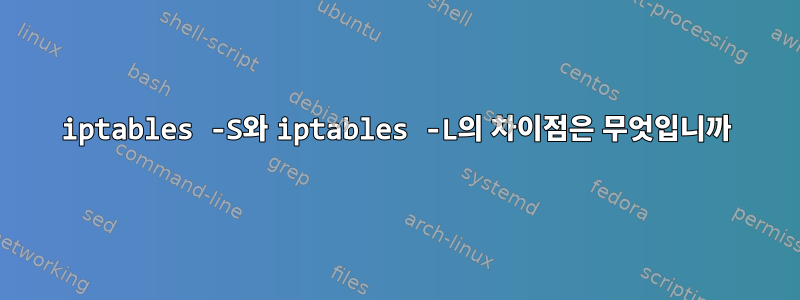
도움말 정보는 그다지 유익하지 않은 것 같습니다.
--list -L [chain [rulenum]]
List the rules in a chain or all chains
--list-rules -S [chain [rulenum]]
Print the rules in a chain or all chains
유일한 차이점은 단어 선택입니다: "목록"과 "인쇄".
설명서는 좀 더 자세하지만 여전히 도움이 되지 않습니다.
-L, --list [chain]
List all rules in the selected chain. If no chain is selected, all chains are listed. Like every other iptables command, it applies to the specified table (filter is the default), so NAT
rules get listed by
iptables -t nat -n -L
Please note that it is often used with the -n option, in order to avoid long reverse DNS lookups. It is legal to specify the -Z (zero) option as well, in which case the chain(s) will be atom‐
ically listed and zeroed. The exact output is affected by the other arguments given. The exact rules are suppressed until you use
iptables -L -v
-S, --list-rules [chain]
Print all rules in the selected chain. If no chain is selected, all chains are printed like iptables-save. Like every other iptables command, it applies to the specified table (filter is the
default).
내 생각에 이것은 -S실제로 더 장황하며 매개 변수를 통해 허용하는 정확한 포트를 인쇄합니다 --dports. 그런데 왜 그럴까? "인쇄"라는 단어가 자동으로 "목록"보다 더 높은 수준의 세부 정보를 의미한다고 생각하지 않습니까?
답변1
차이점은 출력 형식에 있습니다. 이 -S옵션은 형식으로 생성됩니다 iptables-save. 이는 와 함께 iptables-apply재사용 할 수 있습니다 iptables-restore. ( man자세한 내용은 해당 페이지 항목을 참조하세요.) 따라서 차이점을 다음과 같이 생각할 수 있습니다.
-L참고로 밖에 뭐가 있는지 알고 싶어요-S재사용 가능한 출력용, 기계 구문 분석용
-S이 옵션이 더 자세한 정보를 제공한다고 생각한다면 iptables더 자세한 정보를 제공하는 다른 매개변수 학습과 결합 해야 합니다 -L.


